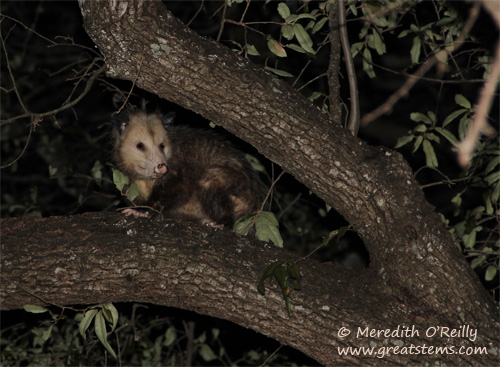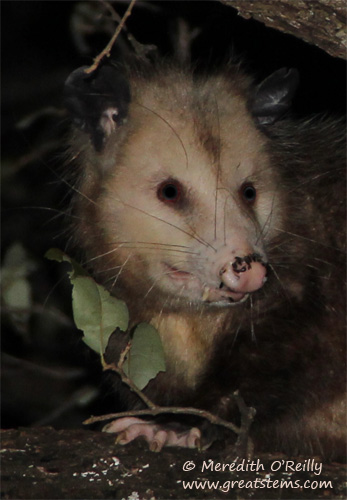So I finally got a picture of one of our friendly neighborhood opossums. It likes to visit the sideyard pond for a drink from time to time. I’m thrilled, because in one week’s time, I managed to get three wildlife photos I hadn’t had before — a rattlesnake and scorpion last Saturday, and now an opossum!
 Now there’s a face only a mother could love (well, and me — but then again, I’m technically a mother, so I guess it counts).
Now there’s a face only a mother could love (well, and me — but then again, I’m technically a mother, so I guess it counts).
Since Virginia Opossums are the only opossums living in Texas, there’s no question what species we have in our neighborhood. Virginia Opossums are our one North American marsupial. The young are born about the size of a bean, and they immediately crawl up to mama’s pouch to nurse and continue growing. When full grown, they will be about the size of a housecat. And then they’ll eat all sorts of anything — insects, fruits, berries, and even small mammals, birds, and reptiles. Perhaps that’s one reason why opossums do well in an urban environment (that and the fact that so many people still feed their cats outdoors, and opossums are big fans of cat food).
Opossums are sometimes called “living fossils” because they haven’t changed much in the past 50 million years. Here in Texas, they are our oldest mammal species. What’s nifty is that their lower body temperature makes them highly resistant to rabies and rattlesnake venom.

Aside from that adorable nose, whiskers, and grin, check out the feet. Strong claws and opposable thumbs make opossums great climbers. They’ve even got a prehensile tail.
If frightened, an opossum might hiss at you before running away, quite an alarming sight if you get a good glimpse of its 50 teeth. But when truly scared, an opossum can go catatonic for many minutes to a few hours (hence the term “playing possum”). Its heartrate and breathing slow down dramatically, so it is actually more in shock than just feigning death.
Opossums are some of our most misunderstood urban animals. They are shy and non-destructive, and they are unlikely to carry rabies, but they will visit your patio if you leave cat food out. They might even share the cat food bowl with your pet. Sometime I might tell you the giant-rat story from my youth, but today I’ll just spoil the surprise and tell you that it turned out to be the most adorable juvenile opossum hiding in our curtains and not a giant rat at all. Ever since then, I’ve had quite a fondness for opossums. Just look at that cutie!
Although kind of creepy, these are fascinating animals. I love their feet — an opossum footprint is so unique!
I agree, Alan — and I love studying animal tracks, too.
And here I figured I was the only one that liked possums. 🙂
Great capture! Sadly, I only ever seen them as roadkill and then they are not so cute. They really do provide a useful service in our gardens.
Yay, Katina!
Karin, I kept thinking that our opossum looked older, but it turns out they typically only live 1-2 years in the wild. I was very surprised!
I’ve found one dead at my gate (don’t know why) and several alive, playing dead, when my dogs surrounded! They make a unique sound and do have a lot of teeth behind that grin.
Meredith: found a very comprehensive PDF from the University of Missouri about Oppossums:
http://web.missouri.edu/~krausew/Histology/Home_files/opossum.pdf
Confirms what you said about short lifespan — those that make it to two years old show signs of advanced age. In captivity can last 4 years, with the rare individual making it to 10.
You’re right about that, Carol — they are unique in many ways.
That’s a great resource, Alan — thank you. Wow, they have the shortest gestation of any mammal — and the tiny little babies are completely unrecognizable as opossums, except perhaps their already long “fingers.” Fascinating read — I’ll keep it handy!
I have seen one in my western NY state yard from time to time and of course in the road…they are misunderstood…
If you have a chance to read through Alan’s link in the comments, you’ll learn even more about them — it’s worth it!